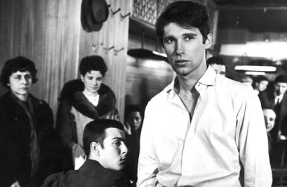
What you see is what you get. A man drifts around a small Dutch village, alone, video camera in hand, ringing random door bells. Whenever someone opens their door, he continues to film them in silence and with an apparently blank face, until something happens. What might sound like a sketch out of Yoko Ono’s Grapefruit (or Monty Python’s Flying Circus) is an unlikely concept for an audience favourite at a documentary film festival in this day and age. Yet without spoiling the plot (there is none), we can say that, despite opening as a genuinely disturbing piece of home-invasion psycho-horror, Guido Hendrikx’s real-life one-man show A Man and a Camera actually manages to end on a feel-good note.
In the neo-Vertovian role of the silent stranger come to town, Hendrikx is never seen in the film save for his shadow or the occasional glimpse of his blurred reflection in a door’s windowpane; all we get are the curious, confused, sometimes violent reactions of the involuntary participants in his sociocinematic experiment. The true protagonist of A Man and a Camera, however, is the latter half of the titular duo. There is a basic understanding at work here that the very act of filming is transgressive, and that being filmed generates an alienating self-consciousness in the unwilling subject of the camera’s attention. In any social situation, the presence of a camera makes for an uneven game; through his repeated acts of passive-aggressive monomania, Hendrikx simply amplifies this dynamic to study its effects.
Through a certain lens, none of this may appear overly radical in an era that has already assimilated the likes of Michael Moore, the Yes Men, and Borat, who place filmmaker participation and squirming embarrassment (of the onscreen participants and/or the viewers) front and centre. But the unique sensations of unease, guilt, and even horror that Hendrikx’s in-your-face provocation elicits places it within a far more pronounced and controversial lineage of nonfiction filmmaking—let’s call it the interventionist documentary. To mark out this category’s boundaries via a bit of polemical compare- and-contrast, we can say that, as documentaries have historically been driven by humanistic ideals of equality, solidarity, tolerance, and social justice, the mostly well-intentioned makers of these films have aimed to rebalance the power dynamic between filmer and filmed, even if these efforts have been largely unsuccessful.
In opposition to this, the interventionist film is defined by the active participation of the filmmaker in the






